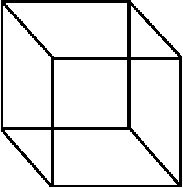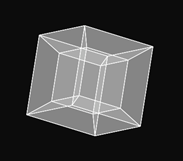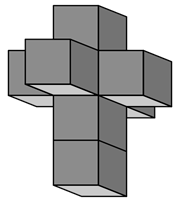Non-Euclidean geometry in the Bible. Really

By Elizabeth Prata

Humans live in a three-dimensional world. The three dimensions are commonly called length, width, and height. A cube is a typical three dimensional object:

If you unfold a cube you get this:

In Euclid’s famous “Elements” treatise two thousand years ago, Euclid, the father of Geometry, said that “a point has no dimension at all. A line has only one dimension: length. A plane has two dimensions: length and breadth. A solid has three dimensions: length, breadth, and height. And there it stops. Nothing has four dimensions.”
Euclid’s axioms spawned Euclidean Geometry, and for two thousand years that was it, there was only Euclidean Geometry (and three dimensions). Then “In 1854, George Bernhard Riemann broke the cult position that the Euclidean geometry had for two thousand years with the introduction of the theory of higher dimensions. In the paper “On the hypotheses which lie at the foundation of geometry“, Riemann exposed the novel properties of higher dimensional space and demonstrated that Euclid’s geometry is based only in the perception.”
In other words, it seems there ARE more than three dimensions!
If it was only in 1854 that mathematicians began experimenting with geometric representations in space and in math of objects in the fourth dimension… If Euclid said that there’s ‘length, breadth, and height and there it stops’, how then could the Bible speak of four dimensions two thousand years ago as here in Ephesians?
“so that Christ may dwell in your hearts through faith; and that you, being rooted and grounded in love, may be able to comprehend with all the saints what is the breadth and length and height and depth, and to know the love of Christ which surpasses knowledge …” (Ephesians 3:17-19a)
Do you want depth of vision? A four dimensional world has length, breadth, height, and depth!
Stay with me here: “Three-dimensional objects are bounded by two-dimensional surfaces: a cube is bounded by 6 squares. A four-dimensional cube, known as a tesseract, is bounded by 8 cubes.” A tesseract is a hypercube, a square figure with four dimensions to it, like a cube has three, and a square has two. Since we are three-dimensional humans, we can’t really accurately depict a four-dimensional object, but the closest we can come is this: a sort of cube within a cube with other cubes adjacent along each plane-

The 4D cube (tesseract) can be unfolded into eight cubes, just as the cube can be unfolded into six squares. There are three cubes meeting at every vertex … You see it gets complicated fast. If you unfold a 4D (tesseract, also known as a hypercube) it will look like this:

And once more for effect, an unfolded 3D cube and an unfolded 4D hypercube next to each other:

Albert Gleizes said, “Beyond the three dimensions of Euclid we have added another, the fourth dimension, which is to say, the figuration of space, the measure of the infinite,” The fourth dimension is the measure of the infinite. As soon as we go from the 3D solid to the 4D we go from known and understandable solid to the infinite. In the Ephesians passage, the breadth and length and height and depth of His love, is so far from our limited understanding,”it surpasses knowledge”.
Salvador Dali captured the infinite love of God in his work, “Crucifixion.” In that famous work, Dali showed Christ on an unfolded hypercube, ascending. If unfolded again, the shadow of the 3D hypercube hovering over the tiles below becomes a 2D representation of the tiles on the ground. Dali knew the mathematical principles behind his work and was purposeful in showing Christ as Master over four dimensions, and three, and two. Just as Ephesians says. The ‘son of God’ Himself is, by the way, a 3D representation of the 4D God.

The point in all this is not only that the Bible once again wrote about maths and science that humans didn’t “know” until centuries later (a spherical earth, gravity, four dimensions) but of the infinite depths of His love, love that exists in dimensions “which surpasses knowledge.”
And he loves you. He knows you: your name, the number of hairs on your head. He knew you before you were born. He wants to be with you, He delights in you. Aren’t you grateful He sent you grace through faith to repent? You can praise His gift of love and can be with Him in His word, commune with Him in prayer. His love may surpass our knowledge but it certainly doesn’t surpass our ability to receive it.





